Types of Clay Treatments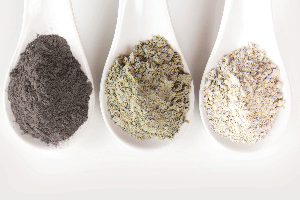
Pelotherapy – This treatment is the therapeutic application of clay and/or mud through peloids – localized applications – or clay baths. Peloids are a mixture of matured organic and inorganic material and lake, sea salt, or minero-medicinal water.
Cataplasms – Cataplasm treatments involve applying cool mud, lower than body temperature, to a small area of the body. As the clay cools the area of the body undergoing treatment, it acts like an anti-inflammatory agent. Cold muds are used to help with acute conditions such as inflammation or congested areas.
Mud Baths – Mud baths are used for treating extensive areas of the body and involve submerging the entire body or parts of the body. The temperature of mud baths will vary, depending on the treatment objectives.
Geotherapy – This treatment involves mixing one or more clay minerals with water and directly applying the mixture on the skin in a consistent one centimeter-thick layer. Depending on the total body area being treated, geotherapy might consist of cataplasms or mud baths.
The Origin of Clay
Clay refers to the finest sedimentary grains and consists of different minerals and organic matter. Clay minerals are formed by the weathering of other silicate minerals on and in the Earth's crust.
Clay and clay minerals form under a limited range of geologic conditions, making them one of the most remarkable ingredients in spa treatments. Some examples of the scenarios under which clay is formed include soil horizons, marine and land sediments, weathering rock formations, volcanic deposits, and geothermal fields. In total, there are nine groups of clay. Most clay forms where water, air, or steam have contact with rocks, such as when boulders undergo weathering on a hillside, when rocks are exposed to water heated by molten rock, or when sediments lie at the bottom of bodies of water. Extensive alteration of rocks into clay minerals can produce significantly pure clay deposits.
Clay Types
Some of the various types of clays used in body treatments include bentonite, ghassoul clay, and kaolin clay.
Bentonite – Bentonite is a generic term for rocks that come from altered volcanic ash beds, consisting predominantly of smectite minerals – in most cases, montmorillonite. With its strong negative electrical charge, which draws out positively charged toxins, bentonite is especially helpful for oily skin. Bentonite deposits exist wherever volcanic eruptions have occurred and ash has not been destroyed by erosion. The western United States, mostly Wyoming, mines approximately 35 percent of the 10 billion tons of bentonite that are mined worldwide each year. Greece is the second largest producer of bentonite; notable reserves also exist in Sardinia, Italy; India; China; and Australia.1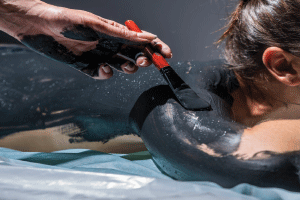
Ghassoul Clay – Ghassoul clay, also known as rhassoul clay, comes from a single place – the only commercial Moroccan deposit to the east of the Middle Atlas Mountains in the Moulouya Valley. For centuries, health enthusiasts and skin care professionals have used it in natural cosmetic products, like soaps, shampoos, and skin conditioners. Most often, it is marketed for its cleansing and oil-removing properties. Only products that contain very specific percentages of the clay minerals stevensite and hectorite may be marketed under the name ghassoul. With its strong drawing properties, rhassoul clay is well suited for oily skin.
Kaolin Clay – Rocks rich in kaolinite, a clay mineral, form the soft, earthy clay known as kaolin. With its low shrink-swell capacity and less intense drawing properties, kaolin clay serves dry, sensitive skin types well. Produced by the chemical weathering of aluminum silicate minerals like feldspar, kaolin clay is often white or takes on a yellow-, light orange-, or rust-colored hue if it is formed in an area with iron oxide.
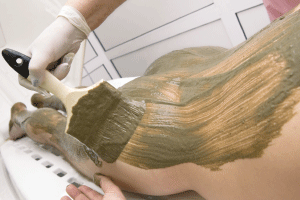 The History of Clay Use for Health and Beauty
The History of Clay Use for Health and Beauty
The use of clay for medicinal purposes goes back in time almost as far as mankind itself. Clay concoctions, consisting of clay mixed with water and different types of natural earth pigments known as ochre, were applied to the skin to cure wounds, calm irritations, and cleanse the skin. In ancient Greece, mud materials were applied as antiseptic poultices to cure skin conditions. Respected healers and scientists, including Hippocrates and Aristotle, developed classifications of medicinal earths based on the substances' properties or mineralogical composition. The Mesopotamians and ancient Egyptians used medicinal earths, such as Nubian earth, as anti-inflammatory agents and Cleopatra used medicinal earths extracted from the Dead Sea for cosmetic purposes. The evolution of mineralogy and crystallography and an increased knowledge of raw materials in the 18th and early 19th centuries fueled the use of clay in pharmaceuticals and cosmetics.
The Skin Benefits of Clay
Clay-based skin treatments offer three primary benefits: detoxification, problematic skin relief, and anaegesia.
Detoxification
Clays have important minerals, drawing capabilities, and detoxification properties that are valuable for enhancing skin health. With the ability to draw and absorb various substances, clays remove impurities from the skin.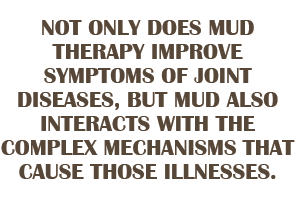
Because clay minerals and organic matter tend to be negatively charged, they attract and hold positively charged ions (cations) on their surfaces through electrostatic forces. Different types of clay have different holding capacities because of varying cation exchange capacities. With their high absorption and adsorption capacities, due to their high specific surface area, dense clays such as bentonite and ghassoul are most effective at drawing out and absorbing secretions, toxins, and contaminants from the skin.
Problematic Skin Relief
For skin suffering from inflammation and conditions like acne and seborrhea due to increased sebum secretions, clay's absorption and adsorption properties can help provide some relief. Clays absorb skin secretions, oils, toxins, and even bacteria.
One effective way to use clay for this purpose is via geotherapy. For problematic skin, it is recommended to apply the clay mixture in a layer that is of about one centimeter thick and at a temperature of approximately 104 degrees Fahrenheit. The heat stimulates perspiration, opens sebaceous glands, and causes sebaceous secretions to flow more easily.
Clay-based products that have a high surface area, like those with bentonite or ghassoul clay, are best-suited for treating problem skin.

Analgesia
The validity of spa treatments as a way to minimize acute or chronic pain is still up for debate, but some studies suggest that they offer benefits to those suffering from a variety of diseases and conditions marked by inflammation and muscular, joint, and nerve pain.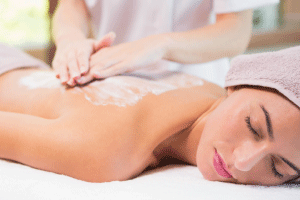
Peloids, as thermal mud therapy or packs, have been considered helpful for treating musculoskeletal system illnesses. Peloids have anti-inflammatory, stimulatory, and analgesic properties, which may be beneficial for a variety of issues, including joint inflammation, degenerative osteoarthrosis, muscle pain, nerve pain, bone fractures, joint dislocations, and sprains.
Thermal mud therapy produces a sensation of heat to the specific area treated and, in the process, it dilates blood vessels, increases perspiration, and stimulates the respiratory and cardiac systems. According to numerous medical studies, heat reduces muscle contraction, provides pain relief by relaxing muscles, and reduces joint stiffness by increasing the extension of joint collagen.2 For these reasons, heat plays a critical role in thermal mud therapy's healing effects. In clinical observations within spa environments, beneficial effects have been seen from the second week of therapy with improvements occurring in the weeks after and lasting for three to five months.2
Research has shown mud therapy to significantly decrease circulating levels of cell signaling proteins (TNF-alfa and IL-1), which plays a key role in the regulation of inflammatory responses, thereby providing joint pain relief and reducing the progression of arthritic degeneration.2 In addition, recent studies have also indicated that mud therapy helps thwart the activity of free radicals associated with osteoarthritis. Regenerative effects on joint collagen and cartilage and reduction in joint inflammation have also been shown via other experimental studies. Not only does mud therapy improve symptoms of joint diseases, but mud also interacts with the complex mechanisms that cause those illnesses.
In addressing inflammation, thermal mud-pack therapy has significantly reduced serum levels of prostaglandin E2, a hormone-like substance that helps relax smooth muscle tissue, in clients. Muscle relaxation of that kind is normally only achieved using a combination of different medications.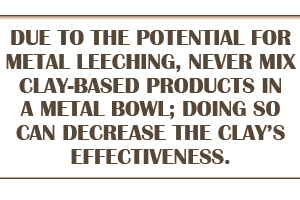
Bentonite, ghassoul, and kaolin all have analgesic properties due to the increase of heat to targeted areas of the body.
With diverse origins, rich history, and fascinating science, clay is an ingredient worth exploring and understanding. As professionals strive to deliver an exceptionally satisfying spa experience to their clientele, they should consider the inherent drawing, detoxifying, soothing, and analgesic qualities of clay and the multiple benefits of clay-based body treatments.
References
1 Williams, L. B., & Haydel, S. E. (2010). Evaluation of the medicinal use of clay minerals as antibacterial agents. International Geology Review, 52(7-8), 745–770.
2 Tateo, F., Ravaglioli, A., Andreoli, C., Bonina, F., Coiro, V., Degetto, S., ... Summa, V. (2009). The in-vitro percutaneous migration of chemical elements from a thermal mud for healing use. Applied Clay Science, 44(1-2), 83–94.
3 Pura, A., Dusenkova, I., & Malers, J. (2014). Adsorption of organic compounds found in human Sebum on Latvian Illitic, Kaolinitic, and Chloritic Phyllosilicates. Clays and Clay Minerals, 62(6), 500–507.
 Heather Kreider, co-owner of Makes Scents Natural Spa Line, has lived and breathed the spa industry for 19 years. Her credentials include post-graduate certification in advanced skin care at the International Dermal Institute and experience as an aesthetician specializing in European skin care. Besides her company's signature line of products, they also create custom formulations for spas that wish to offer their own distinctive treatments. All of their products are certified cruelty-free by the Coalition for Consumer Information on Cosmetics. 717-824-3094 or
Heather Kreider, co-owner of Makes Scents Natural Spa Line, has lived and breathed the spa industry for 19 years. Her credentials include post-graduate certification in advanced skin care at the International Dermal Institute and experience as an aesthetician specializing in European skin care. Besides her company's signature line of products, they also create custom formulations for spas that wish to offer their own distinctive treatments. All of their products are certified cruelty-free by the Coalition for Consumer Information on Cosmetics. 717-824-3094 or
This email address is being protected from spambots. You need JavaScript enabled to view it.
Want to read more?
Subscribe to one of our monthly plans to continue reading this article.